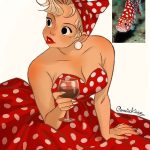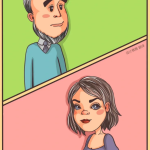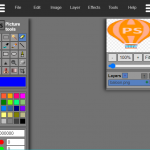4-1 Know the constituency
Photoshop needs to specify an area when processing a partial image, that is, it needs to create a selection. Selection can limit editing to a certain area, so that we can process partial images without affecting other content. If no selection is created, the color of the entire photo will be modified. The selected area can separate the image, that is, cut out, separate the selected part from the background and put it into a new background. The selection area can be divided into two types: ordinary selection area and feather selection area; the ordinary selection area has a clear boundary, and the boundary of the image selected using it is clear and accurate. Use the feather selection area to select the bereaved image, and its border will appear gradually transparent. After changing the background effect, when compositing the object with other images, proper feathering can make the composite effect more natural.
4-2 Method of Cutout
Cutout: After selecting the object and separating it from the background, the whole process is called cutout. There are many methods in ps, and the portrait and hair need a variety of tools to cut out.
1) Basic shape selection method
Objects with round, oval, or rectangular edges can be selected with the marquee tool. There are also lasso and polygon tools.
2) Color difference selection method
If the difference between the object and the background is obvious, you can use the quick selection tool, magic wand tool, and color range to select.
3) Quick mask selection method
4) Adjusting the edge is a command used to modify this area.
5) Pen tool
6) Channel selection method. It is suitable for selecting objects with rich details such as hair, as well as transparent objects such as glass, smoke, wedding dresses, etc., as well as flags blown by the wind, and objects with blurred edges such as cars when driving at high speed. Edit the selection with tools such as brushes, filters, selection tools, and blending modes.
7) Install the plug-in and choose Cutout
4-3 Basic operation method of selection
1) Select all and reverse
Execute “select-all” ctrl+A to select all images within the current document boundary. “Select-Reverse” command, “shift+ctrl+I” can reverse the selection
2) Please select translation and re-select
“Select-Deselect” “ctrl+D”
“Select-Reselect” to reselect the last selection
3) Selection calculation
New selection: create a new selection, if there is a selection in the image, the newly created new area will replace the original selection
Add to selection: add new and original selections
Subtract from the selection: subtract the new selection from the original selection
Intersect with constituency: the original constituency intersects with the new constituency
Shortcut keys: shift plus selection, Alt minus selection, shift+Alt plus selection.
4-4 Move selection
1) Move the selection when creating a selection. When creating a selection, before releasing the mouse button, hold down the space bar and drag the mouse to move the selection
2) Move the selection after creating the selection
To create a selection distinction, use the selection tool to place the selection in the selection area, and then drag the mouse to move the selection area. If you want to move the selection slightly, you can press the keyboard arrow keys to move.
3) Hide and show the selection area, ctrl+H, hiding the selection area does not cancel the selection area, the function of the selection area still exists.
4-5 actual combat
1) Basic selection tools
Rectangular marquee, oval tool, one-way single-column tool, lasso tool, polygonal lasso tool
Use the ellipse tool to click and drag the mouse to create an elliptical machine to select this; hold down the Alt key to create a selection centered on the single out point; hold down the shift+Alt key. A circular selection will be created with the clicked point as the center and outwards.
Polygonal lasso tool: When creating a selection, hold down the shift key to operate, you can lock the horizontal, vertical, or draw in 45 degree increments. If you double-click, a straight line will be connected between the double-click point and the starting point to close the selection.
When using the polygonal lasso tool to create a selection, hold down the Alt key and click and drag the mouse to switch to the lasso tool. At this time, drag the mouse to draw the selection freehand; release the Alt key to return to the multilateral trading arbitrage tool .
When using the magnetic lasso tool, press the Caps Lock on the keyboard, and the cursor will turn into a ten circle. The size of the circle is the width of the edge that the tool can detect. Press the square bracket key to adjust the detection width.
2) Magic wand and quick selection tool
The magic wand and the quick selection tool are tools for constructing selections based on tones and color differences, allowing you to quickly select areas with similar tones.
The magic wand tool option bar is clear:
-[] Sampling size: used to set the sampling range. Select “sampling point” such as “3*3 average”
-[] Tolerance: Determine the tonal range of the click point, when it is low, only select a few colors that are very similar to the pixels of the click point. When it is high, the color range is larger. The click point is different, the selected area is also different
-[] Continuous: Check this option to select only the areas connected by the color; when unchecking, you can select all areas with the same color as the mouse click, including the areas that are not connected.
-[] Sample all layers. Check this option to select all areas with similar colors on the visible layers. Uncheck it, only the areas with similar colors on the current layer will be selected.
3) Cut out the picture with the quick selection tool
The icon is a brush ➕ the outline of the selection area, so the method of use is similar to the brush. You can quickly paint the selection area like a brush. When you drag the mouse, the selection area will expand outwards and automatically find and follow the edges defined in the image.
Option bar description:
Selection operation button: can add or subtract.
Pen tip drop-down panel: pen-related settings can be set, and the bracket keys can be used to adjust the size.
Sample all layers:
Automatic enhancement: can reduce the roughness and blockiness of the selection boundary, can automatically further flow the selection to the edge of the image and apply some edge adjustments
4) “Color Range” command
Creating a selection based on the color range of the image is similar to the magic wand tool, except that it has more control options and higher selection accuracy.
The dialog box description is as follows:
-[] Selected area preview: check “Select Range” below the preview, the preview is black, white and gray, white represents selection, black represents unselected area; gray represents partial selection, feathered area. If you check “Image”, the color image will be displayed in the preview area.
-[] Selection: It is used to set the creation method of the selection. “Sampling mode” displays the straws, you can take samples in the document window, you can also get samples on the preview image, add the 10th straw, and reduce the 1st straw. In the drop-down list, you can also create selections with specific colors. You can also choose “Highlight”, “Midtone”, “Shadow”, “Overcolor”, and “Skin tone”
-[] Selection preview: used to set the preview mode of the selection in the document window. None: indicates that the selection area is not displayed in the window; gray scale: the selection area is displayed according to the appearance of the selection area in the gray channel; black matting: covering the unselected area with a layer of black; white matting: covering the unselected area with a layer White; quick mask: unselected areas are covered with a layer of ruby red.
-[] Detect human face: select when selecting human skin
-[] Localized color cluster/range: Drag the range slider to control the maximum and minimum distance between the color contained in the mask and the sampling point. If you want to select one of the two flowers, you can click on one of them to sample, and then adjust the “Range” value to shrink the range, so that you can avoid selecting the other flower.
-[] Color tolerance: used to control the selection range of colors.
-[] Store/Load: Store and load selection presets.
-[] Invert: Invert after creating a selection
! If the image has created a selection area, the “color range” will only analyze the selected image. If you want to fine-tune and select this, you can use this command again.
【】Color range” case study:
1) Open the file of the material angel girl, execute “Select-Color Range” and click on the character background to sample the color.
2) Press the “Add to” button to add all the background area to the selection and turn it into white
3) Drag the “Color Tolerance” slider back to leave some translucent pixels on the edges of the feather wings.
4) “OK”-execute “Select-Reverse” again, and the selection is changed from the background to the little girl. You can use the move tool to move the little girl into another document.
! The “color range” is the same as the magic wand and the quick selection tool in that the selection is created based on the difference in tones. “Color Range” can create a selection with feathering. That is, the edges can be semi-transparent and blend with the background. The magic wand and quick selection tool cannot.
【】Quick Mask
It is a selection area conversion tool that converts the selection area into a temporary mask image. In this way, we can edit the mask with brushes, filters, and other tools, and then convert the mask into a selection. The Q key is turned on, and the X key switches between black and white colors. Smear white to extend the selection, smear black to reduce the selection, and gray to get the feathered selection. Q key back to normal mode:
Option bar description:
-[] Masked area: Refers to the image outside the selected area. “Color indicator” can specify the background overlay color outside the selected image.
-[] Selected area: “Color indicator”
-[] Color/Opacity: Click the color block to open the color picker, you can adjust the color and transparency
【】Adjust the edge
In the case of creating a rough selection, then use the edge adjustment to refine the selection, remove noise, etc. to optimize the selection? The dialog box description is as follows:
-[] Flashing dotted line, standard selection, when there is a feathered edge, the selection is at more than 50% pixels.
-[] Overlay, fast mask state
-[] Black background, black background (no area selected)
-[] White background, white background. Select area to be colored
-[] Black and white, channel mask status
-[] Background layer: view transparent background image
-[] You can view the entire layer without displaying the selection area.
-[]
-[] ”Adjust selection edge” can smooth, feather, and expand the selection. The dialog box description is as follows:
-[] Smooth; create a smoother selection outline.
-[] Feathering; you can set the feathering for the selection (range 0-250 pixels)
-[] Contrast: Sharpen the edges of the selection and remove the unnaturalness of blur. For a selection with a feathering effect added, increasing the contrast can reduce or eliminate the feathering.
-[] Move the edge; negative value shrinks the edge of the selection, positive value expands the edge of the selection…
-[] Specify the way of losing:
-[] Purify Color: After checking this option, drag the “Quantity” slider to remove the color noise of the image. The brighter the quantity value, the wider the clearing range.
-[] Method of output selection: selection, add a selection; layer mask, output mode of selection with layer mask; create a new layer and output selection; create a new layer with layer mask; new Document and output selection.
“Adjust the edge” case:
1) Open the dog dog material and use the quick tool to create the “dog dog” selection area.
2) Click the “Adjust Edge” button in the tool option bar
3) Select the “Black and White” view mode, check “Smart Radius” and “Purification Color”, and drag the radius to roughly select the hair.
4) Click to adjust the radius, erase the adjustment tool (eraser) and smear the excess background to exclude it from the selection.
5) In the “Output to” drop-down list, select the “New layer with layer mask” option, and then click the “OK” button, and then click the “OK” button.
Refinement tools and edge detection options
Adjust the radius tool: can expand the detection area
Erase adjustment tool: (Eraser) can restore the original edge.
Smart radius: make the radius automatically fit the side image of the image.
Radius: Control the size of the adjustment area. ,
4-6 Edit operation of the selection, you can process and edit the selection.
1) Create a boundary selection (circle)
Execute “Select-Modify-Border” and “Width” to set the size of the expansion, such as 30 pixels, and the original selection will expand 15 pixels outward and inward respectively.
2) Smooth selection
“Select-Modify-Smooth”, you can use the “Smooth” command
3) Expand and shrink the selection
Execute the “select-modify-extend” command.
Perform “select-modify-shrink” to shrink
4-7 Feather the selection area and control the size of the feathering area
4-8 Expanding selection is similar to selection
4-9 Apply a transformation to the selection.
4-10 storage selection
4-11 Load selection
1) Press and hold ctrl+click the channel thumbnail to load the selection into the image.
2) “Select-Load Selection” can load the selection, the dialog box is as follows:
Document: Used to select the target file containing the selection
Channel: used to select the channel containing the selection
Reverse: execute the “reverse” command after loading the selection
Operation: If the current document contains a selection, you can perform calculations with the loaded selection.
Please indicate:Free Editor Online Photoshop » Online photoshop self-study manual






 Gender Double Label Revealed 9 Illustrations Reveal the Invisible Rules Around Us!
Gender Double Label Revealed 9 Illustrations Reveal the Invisible Rules Around Us!





Login to comment! If you already have an account, please first log in,No please registered or